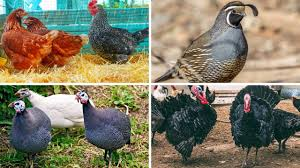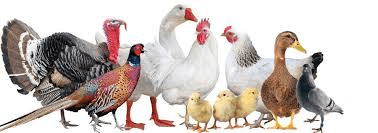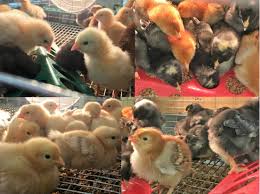Nutritional deficiency can only occur when feed feed producers fail to ensure balanced rations for birds. In this case, most of vital vitamins required for birds to grow well, healthy and maintain high production of eggs would not be present such as Pyridoxine B6, Inositol, Vitamins A.D3.D etc.
As a result of this, some unexpected defects are bound to occur and these include paralysis of legs, wings, poor egg production and slow growth may occur.
Prevention: To prevent this situation, the feed producers are advised to always supply poultry farmers with balanced rations to enable birds have all the vitamins mentioned above to boost growth and maintain adequate egg production.
This on the other hand would make poultry farmers get necessary profits, ensuring balanced ration is not a waste of money but for the benefit of birds and farmers themselves.
Read Also: Coccidiosis Disease in Poultry Farming and How to tackle it
In general, a nutritional deficiency may be due to a nutrient being omitted from the diet, adverse interaction between nutrients in otherwise apparently well-fortified diets, or the overriding effect of specific antinutrients.

The latter two scenarios are difficult to diagnose, because diet analysis suggests a normal level of the nutrient(s) under investigation.
Micronutrients such as vitamins and trace minerals are usually added to diets in the form of stand-alone micro premixes, so it is rare to see classic symptoms of deficiency of individual nutrients—rather, the effect seen is more commonly a compilation of many individual metabolic conditions.
In many instances, a correct diagnosis can be made only by obtaining complete information about diet and management, clinical signs in the affected living birds, necropsies, and tissue analyses.
Unfortunately, tissue, and especially liver and serum analysis, can be misleading, because relative to the time of initial occurrence of any deficiency, the bird often sequesters nutrients in the liver, and so even with deficient diets, liver assays show erroneously high values. This latter effect is most significant for minerals such as copper.

A diet that, by analysis, appears to contain just enough of one or more nutrients may actually be deficient to some degree in those nutrients. Stress (bacterial, parasitic, or viral infections; high or low temperatures; etc.) may either interfere with absorption of a nutrient or increase the quantity required.
Thus, a toxin or microorganism, for example, may destroy or render unavailable to the bird a particular nutrient that is present in the diet at apparently adequate levels according to conventional chemical or physical assay procedures.
Read Also: Worm infection among Poultry Birds: Types, Causes and Treatment
In laying chickens also referred to as laying birds or laying hens, Rickets, Caged layer fatigue (CLF) and Fatty liver syndrome (FLS) are nutritional diseases which are caused by nutritional deficiency and they affect laying hens and can account for a high percentage of the flock mortality.
The laying hens’ diet is specifically formulated to be nutritionally complete, however, the occurrences of these diseases are prevalent especially in hens in high production and the mortality rate in flocks can be high.
Presently, little can be done to avoid conditions such as osteoporosis in laying hens housed commercially in cage systems. The disease can be considered a production disease therefore best husbandry practices can improve flock health.
Meanwhile, Altering the diet by replacing some of the corn with lower energy feedstuff such as wheat bran can help to treat Fatty liver syndrome (FLS).
Aside from nutritional deficiency affecting laying birds, there are other common nutrition-related problems of poultry farming business generally which we are going to discuss about below.
Read Also: Comprehensive Guide on How to start Cockerel Farming Business
Common Nutritional Deficiency related Problems of Poultry
1. Mycotoxins
Mycotoxins are becoming a serious problem in the feed industry. Mycotoxins are toxic compounds produced by molds in animal feeds. Even if the mold is destroyed, the mycotoxin usually remains.
According to a recent research, The Veterinary Diagnostic Laboratory at the Iowa State University College of Veterinary Medicine monitors the levels of mycotoxins in corn in the Midwest area.
The December 2009 report indicated that there is a higher than normal incidence of the corn affected by mycotoxins across Iowa and in samples submitted from six states including Illinois, Kentucky, Michigan, Oklahoma, Texas, and Wisconsin.
Nutritional Deficiencies

For the health and productivity of your birds, it is important that they are fed diets that meet their nutritional requirements.
Complete feeds can be purchased that are formulated to meet all the nutritional requirements (energy, protein, and amino acids, fat, vitamins, macro- and micro-minerals, etc.) of a particular class of poultry.
2. Vitamins Requirement
(1) Fat-soluble vitamins
Vitamin A is required for the health of the membranes of the digestive, urinary, reproductive and respiratory systems. A vitamin A deficiency can result when the level in the diet is inadequate or the vitamin added to the diet is oxidized by rancid fat in the diet.
Additionally, neomycin, a common antibiotic, decreases the absorption of vitamin A. Vitamin A is a fat-soluble vitamin and an inadequate level of fat in the diet could also limit its absorption, even if in the diet at adequate levels.
Symptoms of a vitamin A deficiency include:
- Cheese-like, but odorless, discharge from one or more eye;
- Extremely thin birds (i.e., emaciation);
- Weak and/or uncoordinated birds;
- Ruffled feathers;
- Eyelids stuck together (referred to as sicca);
- Water discharge from the throat (referred to as roup), nostrils or eyes in young birds; and
- Egg production and hatchability decrease in adults
A vitamin D deficiency in poultry results in an inadequate level of vitamin D3 in the diet. Vitamin D3 is needed for proper calcium and phosphorus metabolism and thus the formation of a normal skeleton, beak and claws, and eggshells.
Rickets occurs in young birds while cage layer fatigue (osteomalacia) occurs in mature females. It can be mistaken for other causes of deforming leg weakness in poultry.
A vitamin E deficiency results in a condition known as ‘crazy chick disease’ or encephalomalacia (softening of the brain). In chicks, it usually occurs between 15-30 days of age.
Vitamin E is required for reproduction as well as the normal integrity of the central nervous and muscular systems. Vitamin E is also an effective antioxidant and is an important protector of essential fatty acids (e.g. linolenic acid), vitamin A, and vitamin D3.
A vitamin E nutritional deficiency is typically caused by an inadequate level of vitamin E in the diet. In addition, vitamin E is readily destroyed by heat (a term referred to as heat-labile).
A deficiency of selenium will also result in a deficiency of vitamin E. Selenium levels are low in some areas of the country resulting in lower levels in cereal grains.
Symptoms of a vitamin E deficiency include:
- Uncoordination
- Tremors
- Rapid contractions and relaxation of the legs resulting in what is known as ‘crazy chick disease’
- Testicular degeneration in adult males resulting to decreased fertility
- Increased embryonic mortality
A vitamin E nutritional deficiency resembles Avian Encephalomyelitis (AE), Newcastle Disease (AE), and a vitamin B1 deficiency.
Vitamin K is required for the production of prothrombin which is essential in blood clotting. So a deficiency of vitamin K results in an increase in hemorrhaging. It can cause increased embryonic mortality, with the dead embryos having hemorrhaging conditions.
A vitamin K nutritional deficiency can be caused by a deficiency of vitamin K in the diet. High levels of sulfaquinoxaline, a medication for prevention or treating coccidiosis in chickens and turkeys.
Read Also: 12 Management Tips for better Poultry Performance Potential
(2) Water-soluble vitamins
Vitamin B1 deficiencies result from an inadequate level in the diet. Other causes of a deficiency include excess Amprol (used to treat or control coccidiosis) in the diet; moldy feed; or by rancid fat oxidation.
A deficiency typically takes three weeks to develop. Vitamin B1 is needed for the formation of a coenzyme involved in the function of the nervous system. A vitamin B1 deficiency resembles Avian Encephalomacia (AE), vitamin E deficiency and Newcastle disease.
Symptoms of a vitamin B1 deficiency in young birds include:
- Nervousness
- Ruffled feathers
- Leg weakness
- Unsteady gait
- Paralysis (convulsions with head retraction) called polyneuritis
- Star-gazing (head retracted due to paralysis of the anterior muscles of the neck)
Symptoms of a vitamin B1 deficiency in adults include:
- Blue comb
- Decrease in respiration rate
- Lowered body temperature
Vitamin B2 is a cofactor in many enzyme systems. Most are associated in oxidation-reduction reactions that are involved in respiration. A vitamin B2 deficiency can be mistaken for Marek’s disease since both have enlarged peripheral nerves.
Symptoms of a vitamin B2 deficiency include:
- Curled toes
- Poor growth
- Weak and emaciation in young birds
- Decrease in size of leg muscles (i.e., atrophy)
- Skin is dry and harsh
- Poor hatchability and egg production in adults
- Dead embryos with ‘clubbed’ down feathers.
- Turkeys have severe dermatitis (i.e., inflammation of the skin) in the feet and shanks as well as incrustations on the corners on the mouth.
Read Also: 6 Ways to Enhance Egg Production and Maximize Profits on Poultry Layers
Frequently Asked Questions
We will update this section soon.

